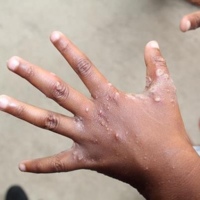Scabies: symptoms, diagnosis and treatment The human itch mite, Sarcoptes scabiei, is a common cause of itching dermatosis infesting ~300 million persons worldwide. Gravid female mites, measuring ~0.3 mm in length, burrow superficially beneath the skin, depositing three or fewer eggs per day. Nymphs mature in ~2 weeks and then emerge as adults to the surface of the skin, where they mate and (re)invade the skin of the same or another host.
Mode of infestation
Transfer of newly fertilized female mites from person to person occurs mainly by intimate contact and is facilitated by crowding, poor hygiene, and multiple sexual partners. Generally, these mites die within a day or so in the absence of host contact. Transmission via sharing of contaminated bedding or clothing is therefore infrequent. In the United States, scabies may account for up to 5% of visits to dermatologists. Outbreaks occur in nursing homes, mental institutions, and hospitals.
Pathophysiology
The itching and rash associated with scabies derive from a sensitization reaction directed against the excreta that the mite deposits in its burrow. An initial infestation remains asymptomatic for up to 6 weeks, and a reinfestation produces a hypersensitivity reaction without delay. Burrows become surrounded by infiltrates of eosinophils, lymphocytes, and histiocytes, and a generalized hypersensitivity rash later develops in remote sites. Immunity and associated scratching limit most infestations to <15 mites per person. Hyperinfestation with thousands of mites, a condition known as crusted scabies or Norwegian scabies, may result from glucocorticoid use, immunodeficiency, and neurologic and psychiatric illnesses that limit itching and scratching.
Symptoms and signs
Intense itching worsens at night and after a hot shower. Typical burrows may be difficult to find because they are few in number and may be obscured by excoriations.
I described this intense itching of scabies in this YouTube video below.
Burrows appear as dark wavy lines in the epidermis and measure up to 15 mm. Lesions occur most frequently on the volar wrists, between the fingers, on the elbows, and on the penis. Small papules and vesicles, often accompanied by eczematous plaques, pustules, or nodules, are symmetrically distributed in these sites and in skin folds under the breasts and around the navel, axillae, belt line, buttocks, upper thighs, and scrotum. Except in infants, the face, scalp, neck, palms, and soles are spared.

Hand scabies. Credit: IACS
Crusted scabies resembles psoriasis in its typical widespread erythema, thick keratotic crusts, scaling, and dystrophic nails. Characteristic burrows are not seen in crusted scabies, and patients usually do not itch, although their infestations are highly contagious and have been responsible for outbreaks of classic scabies in hospitals.
READ ALSO: HPV and genital warts
Diagnosis
Scabies should be considered in patients with pruritus and symmetric polymorphic skin lesions in characteristic locations, particularly if there is a history of household contact with a case. Burrows should be sought and unroofed with a sterile needle or scalpel blade, and the scrapings should be examined microscopically for the mite, its eggs, and its fecal pellets.
Biopsies, scrapings of papulovesicular lesions, and microscopic inspection of clear adhesive tape lifted from lesions may also be diagnostic. In the absence of identifiable mites or mite products, the diagnosis is based on clinical presentation and history. Diverse kinds of dermatitis due to other causes are frequently misdiagnosed as scabies.
Treatment of Scabies
Permethrin cream (5%) is less toxic than 1% lindane preparations and is effective against lindane-tolerant infestations. Scabicides like benzyl benzoate are applied thinly but thoroughly behind the ears, pubic region and from the neck down after bathing and are removed 8 h later with soap and water.
Successful treatment of crusted scabies requires pre-application of a keratolytic agent such as 6% salicylic acid and then of scabicides to the scalp, face, and ears.
Repeated treatments or the sequential use of several agents may be necessary. Although ivermectin has not yet been approved by the U.S. Food and Drug Administration (FDA) for use against any form of scabies, a single oral dose (200 g/kg) effectively treats scabies in otherwise-healthy persons; patients with crusted scabies may require two doses separated by an interval of 1–2 weeks.
Although effectively treated scabies infestations become noninfectious within a day, itching and rash due to hypersensitivity to the dead mites and their excreted and secreted products frequently persist for weeks or months. Unnecessary re-treatment with topical agents may provoke contact dermatitis.
Antihistamines like laoratadine, salicylates, and calamine lotion relieve itching during treatment, and topical glucocorticoids are useful for pruritus that lingers after effective treatment.
To prevent reinfestations, bedding and clothing should be washed and/or dried on high heat or heat-pressed, and close contacts, even if asymptomatic, should be treated simultaneously.
Bathing with tetmosol can help eradicate scabies
Sources:
(1) Harrison’s Principle of Internal Medicine
(2) Read more on WebMD





















